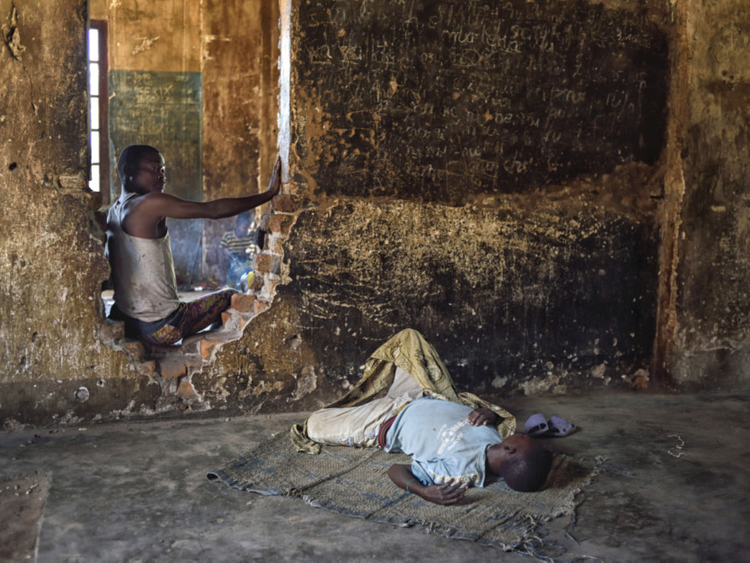
NYUNZU, DR Congo: Deep in the forest, miles from any major city, lies an abandoned cotton factory full of the dispossessed.
There is no police force guarding it. No electricity or running water inside. No sense of urgency or deep concern by the national authorities to do much about it.
Instead, as the days pass, hundreds of displaced people make cooking fires or sit quietly on the concrete factory floor. Dressed in rags, they stare into space, next to huge rusted iron machinery that has not turned for decades. They are members of the Bambote, a marginalised group of forest dwellers who are victims of one of the obscure little wars that this country seems to have a talent for producing.
“It’s like we don’t exist,” said Kalunga Etienne, a Bambote elder.
This is what the Democratic Republic of Congo, the biggest country in sub-Saharan Africa and one that has stymied just about all efforts to right it, has become: a tangle of minibars.
More than 60 armed groups are operating in North Kivu and South Kivu provinces, including a growing Islamist insurgency, whose fighters have hacked hundreds of people to death. Beyond that, there are remnants in the Uele area of the Lord’s Resistance Army, a rebel group that specialises in abducting children and turning them into killers; predatory rebels in Ituri; Bakata separatists in Katanga; armed factions in Maniema; fighters in the Nyunzu area; and youth militias in the capital, Kinshasa.
Few nations in Africa, if not the world, are home to as many armed groups. Even after billions of dollars in aid, one of the largest peacekeeping missions in United Nations (UN) history and substantial international attention over two decades, Congo’s government is incapable of providing the most elemental service: security.
According to several analysts, it says a lot about Congo’s state of affairs when a local war draws in members of a traditional hunter-gatherer group.
“Their existence is so dependent on cooperation,” said Barry S. Hewlett, an anthropologist who has spent decades researching hunter-gatherer communities in Central Africa. “Sharing and giving is essential to their way of life.”
The war started, the Bambote say, in 2014. What set it off was an extramarital affair.
The elders in Nyunzu said a man from another ethnic group, the Luba, had impregnated a Bambote woman. This caused a scandal, not least because the woman was married, and inflamed tensions between the groups.
Respect is key
For generations, some men from the Luba group have chosen brides from communities such as the Bambote. Many elders complained that Luba men had not shown enough respect to the women’s parents.
Scientists believe that the few remaining hunter-gatherers living in Central Africa’s vast rainforest were its original inhabitants. Their adherence to tradition has kept them far behind other groups in education and wealth. At the same time, they have maintained an unusual degree of harmony among themselves and with their environment.
When the Bambote elders confronted the Luba adulterer, he did not apologise. Instead, the elders said, he killed the woman’s husband, setting off a wave of killings between the two communities.
Deeper problems were clearly driving the feud. Analysts point to long-simmering conflicts between the Bambote and the Luba over issues like land rights and labour practices. The local authorities in Nyunzu said it had been customary for the forest dwellers to work for the Luba as field hands for as little as 50 cents (Dh1.84) a day. Sometimes, they were even paid in salt or cassava scraps.
“Historically, they have been exploited,” said Pierre Mukamba Kaseya, head of Nyunzu’s local administration. “All of a sudden, it was as if they woke up and saw the light.”
For the first time anyone could remember, the Bambote banded together in militias and began attacking Luba villages with torches and poisoned arrows. The Luba fought back.
A wave of anger and violence rippled across the green hills. This area is spectacularly beautiful, the Congo often imagined by outsiders — sharp hills, surging rivers, towering forests and lush paths that snake off the road into other worlds.
But soon it was a gruesome killing field. According to a Human Rights Watch report, one survivor heard members of a Luba militia cry out, “We will exterminate you all this year.”
Hundreds, if not thousands, of homes were burnt. So were many schools. People fled in all directions.
Where is the government?
Few, if any, guns were used — axes and arrows were the weapons on hand — but the government presence here is light to nonexistent. Hundreds were killed before the army arrived to intervene — which happens often in Congo.
The violence eventually cooled with the help of local officials, showing that even if Congo’s government is somewhat dysfunctional, it is better than nothing.
But thousands of people remain displaced. It is hard to imagine a more fitting symbol for this country than a cavernous abandoned cotton factory, built decades ago when there was working infrastructure, now full of seized-up machinery and hopeless people.
“We might be stuck here for years,” said Kalunga, the elder. “It’s a rotten life.”
—New York Times News Service












